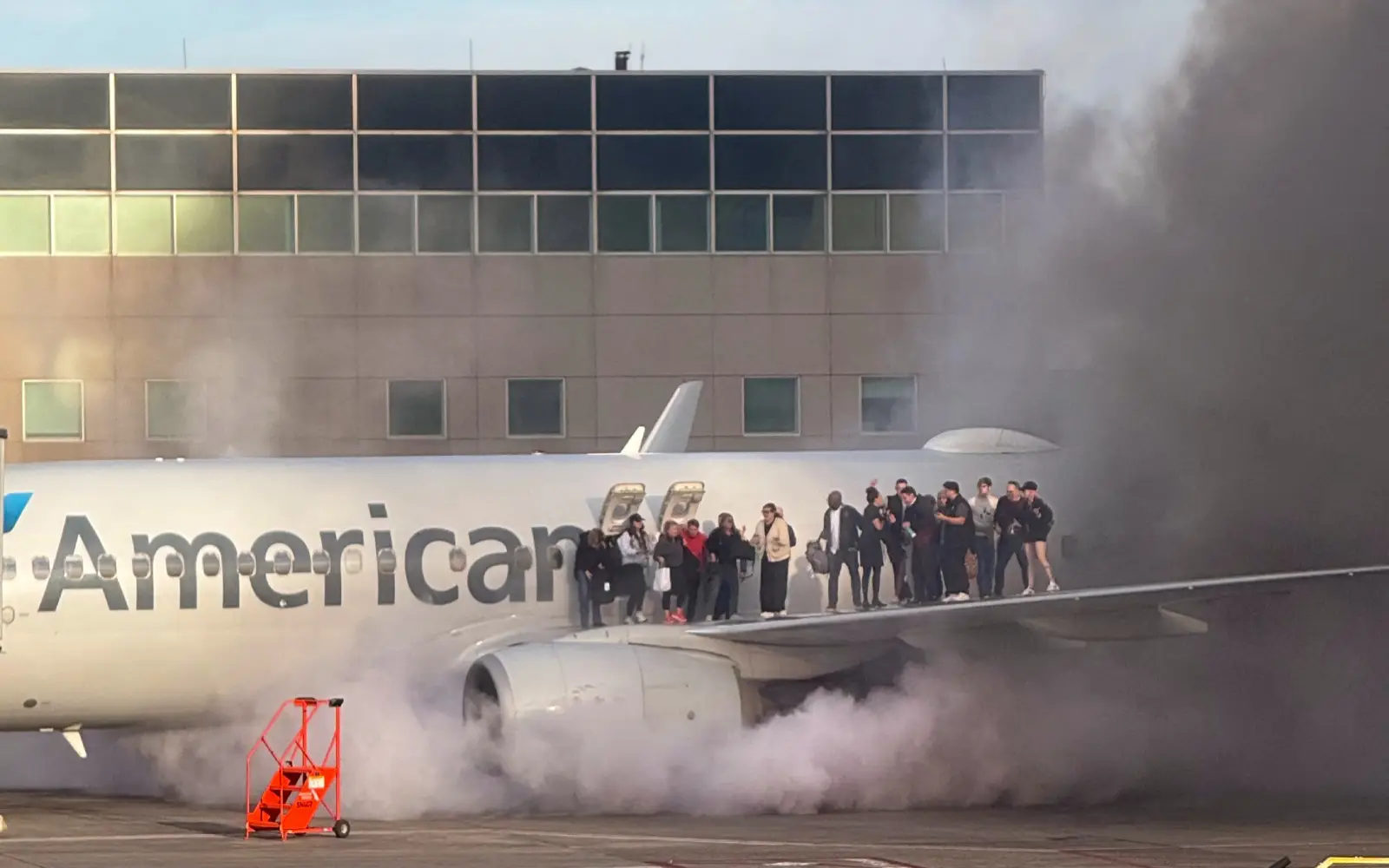On a brisk Thursday afternoon, a routine flight turned into a dramatic emergency at Denver International Airport when an American Airlines Boeing 737-800 caught fire shortly after landing. The incident, which led to the evacuation of all 178 people on board and left 12 with minor injuries, has raised fresh concerns over aviation safety and the ongoing debates surrounding operational cost-cutting within U.S. aviation agencies.
A Sudden Turn of Events
The flight, originally destined for Dallas-Fort Worth, encountered technical difficulties when the cockpit crew reported unusual engine vibrations during the journey. In response, the pilots made the prudent decision to divert the flight to Denver. What seemed at first like a standard precaution quickly escalated into a serious emergency. According to the U.S. Federal Aviation Administration (FAA), as the aircraft taxied toward its gate after a safe landing, one of its engines unexpectedly ignited.
FAA officials detailed that the engine fire erupted while the plane was still on the ground. Passengers, already shaken by the initial delay, were forced to evacuate via emergency slides. Despite the chaos, the swift response of airport emergency teams and the calm, well-coordinated efforts of the flight crew ensured that no lives were lost. However, 12 individuals sustained minor injuries during the evacuation process and were promptly transported to local hospitals for evaluation and treatment.
Eyewitnesses Describe the Scene
Eyewitness accounts from the scene painted a vivid picture of the unfolding drama. Social media platforms were soon abuzz with dramatic video footage that captured billowing smoke around the aircraft and passengers congregating near the wing. Many videos showed passengers on the wing and anxious onlookers gathering to witness the incident as firefighters and emergency crews battled the blaze. One observer described the scene as “chaotic yet remarkably organized,” noting that despite the shock of the situation, everyone seemed to follow the evacuation procedures without hesitation.
The dramatic imagery not only underscored the gravity of the situation but also highlighted the efficiency of emergency protocols in place at Denver International Airport. The rapid deployment of first responders likely played a crucial role in ensuring that the fire did not escalate further, averting what could have been a catastrophic outcome.
The Mechanics Behind the Emergency
Investigators from the FAA have launched a thorough inquiry into the incident. Early reports indicate that the initial concern stemmed from unusual vibrations detected in one of the engines during flight. While such vibrations can sometimes be attributed to relatively benign issues like minor mechanical imbalances, they can also signal more serious underlying problems. The decision to divert to Denver was made out of an abundance of caution, as safety remains the paramount concern for all commercial airlines.
Once the aircraft had landed, the situation deteriorated rapidly when the affected engine caught fire during taxiing. The FAA’s statement, “After landing and while taxiing to the gate an engine caught fire, and passengers evacuated the aircraft using the slides,” succinctly captures the severity and speed of the unfolding events. The precise cause of the engine malfunction remains under investigation, with experts examining everything from routine wear and tear to potential maintenance oversights.
Safety Under the Microscope
This incident comes at a time when the aviation industry is under intense scrutiny. The recent event has added fuel to an ongoing debate regarding the balance between operational cost-cutting and uncompromising safety standards. Critics of recent policy shifts point to a series of minor incidents as evidence that aggressive cost-saving measures might be compromising critical safety protocols. Some industry analysts have voiced concerns that the push to streamline operations has inadvertently led to reduced oversight in areas that are vital for ensuring aircraft reliability and passenger safety.
Former aviation professionals and industry watchdogs alike have urged regulatory bodies to consider these factors seriously. They argue that while cost efficiency is important, it should never come at the expense of thorough maintenance checks, rigorous safety audits, and robust training protocols. In the wake of the Denver fire, many are calling for a comprehensive review of current practices and a renewed commitment to the safety standards that have historically kept air travel among the safest modes of transportation.
A Broader Look at Aviation Trends
The incident at Denver is not an isolated case but rather part of a series of recent events that have put the spotlight on aviation safety. Over the past few months, there have been several reports of mechanical anomalies and near-miss incidents involving commercial airliners. Each incident, while resolved without loss of life, serves as a reminder of the inherent risks involved in air travel and the critical importance of preventive maintenance and swift emergency response.
The aviation industry, with its complex network of regulatory requirements, maintenance protocols, and operational procedures, is continually evolving. However, each time a serious incident occurs, questions inevitably arise regarding whether industry pressures, such as budget constraints and the drive for higher efficiency, might be influencing safety margins. In response to such incidents, regulatory agencies like the FAA typically ramp up their investigations, scrutinizing everything from manufacturing defects to the human factors that may have contributed to the crisis.
Response and Reassurance from Authorities
In the aftermath of the fire, both the FAA and Denver International Airport released statements to reassure the public. The FAA confirmed that a full investigation was underway to determine the root cause of the engine fire, promising that all aspects of the incident would be meticulously reviewed. The airport, meanwhile, praised the exemplary performance of its emergency response teams and emphasized that the safety and well-being of passengers remain the top priority.
Officials also noted that the quick evacuation and minimal injuries were testaments to the effectiveness of current safety protocols. However, they acknowledged that even minor incidents serve as an opportunity for learning and improvement. As a result, the investigation is expected to yield valuable insights that could help refine future emergency response procedures and maintenance standards.
Industry Implications and Future Outlook
As the investigation continues, experts predict that the findings could have far-reaching implications for both airline operators and regulatory bodies. Should the inquiry uncover systemic issues related to maintenance practices or cost-cutting measures, it may prompt a reevaluation of existing policies. Airlines might be required to implement stricter maintenance schedules, while regulatory agencies could face calls for enhanced oversight and more rigorous compliance checks.
Moreover, this incident underscores the critical need for effective communication between flight crews, ground personnel, and emergency responders. The seamless evacuation of all passengers, despite the unexpected engine fire, is a clear indicator that when every component of the safety system functions as intended, even potentially dangerous situations can be managed successfully.
In an industry where trust is paramount, ensuring that every link in the safety chain is as robust as possible is essential. The Denver fire, while fortunately not resulting in any fatalities, serves as a sober reminder that even minor lapses or oversights can quickly escalate into major incidents. It is a call to action for continuous improvement, investment in state-of-the-art technology, and unwavering commitment to the highest safety standards.
Conclusion: Learning from Crisis
The dramatic events at Denver International Airport have provided the aviation community with both a challenge and an opportunity. The immediate focus remains on understanding the technical failure that led to the engine fire, with the FAA’s investigation expected to shed light on any underlying issues. At the same time, the incident has reignited discussions about the balance between operational efficiency and uncompromising safety standards in the industry.
For passengers and industry stakeholders alike, the Denver jet fire serves as a powerful reminder of the inherent risks of air travel. It reinforces the importance of adhering to strict safety protocols and maintaining a vigilant oversight of all systems. While the swift actions of the flight crew and emergency services averted what could have been a tragic outcome, the incident also emphasizes that continuous improvement and careful scrutiny are essential in ensuring that such events remain rare.
As investigations progress and lessons are learned, the hope is that the aviation industry will emerge stronger and more resilient. In the end, every incident, no matter how frightening, provides an opportunity to enhance the safety mechanisms that protect millions of passengers each year. The commitment to learning from these events will not only help restore public confidence but will also pave the way for a safer and more secure future in air travel.
With the full investigation still underway, both passengers and industry experts eagerly await further details. In the meantime, the Denver incident stands as a testament to the critical importance of preparedness, the effectiveness of coordinated emergency responses, and the ongoing need for vigilant oversight in an ever-evolving field.










